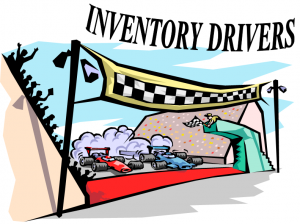 Welcome back to the ongoing series about Inventory Drivers. Changing gears slightly I would like to move from accuracy to Order Quantity. There are two aspects to Order Quantity – Minimum and Maximum. There are also two different operational groups involved – Purchasing and Production. All of these affect inventory levels both directly and indirectly plus you also need to consider whether you are looking at individual materials or aggregate levels. The primary effect of order quantity on inventory levels is reflected in the standard formula for Average Inventory levels of individual items which is:
Welcome back to the ongoing series about Inventory Drivers. Changing gears slightly I would like to move from accuracy to Order Quantity. There are two aspects to Order Quantity – Minimum and Maximum. There are also two different operational groups involved – Purchasing and Production. All of these affect inventory levels both directly and indirectly plus you also need to consider whether you are looking at individual materials or aggregate levels. The primary effect of order quantity on inventory levels is reflected in the standard formula for Average Inventory levels of individual items which is:
Average Inventory = ½ the lot size + safety stock
The immediate and direct effect of this is that the larger the lot size the larger the average inventory. Thus it would appear to make sense to reduce lot sizes as this would automatically reduce average inventory levels. The problem, of course, is that there may be downsides to reducing the lot size. If reducing the lot size increases your cost by more than the value saved by reducing inventory then this is a bad idea. An easy example of this would be if you were receiving a liquid product by tank truck. Reducing the lot size of each order will reduce the average inventory but the cost of shipping will be the same for both lot sizes. Since the cost of transportation per unit is simple the cost divided by the number of units (let’s say Kilograms in this case) then the cost per kilogram goes up as the number of kilograms per load is reduced. (I specified a tank trailer as you probably cannot replace the reduced material quantity with a second material which you could do if the material was in drums in a standard truck.) The point is that the minimum and maximum levels you currently use are probably a reflection of some other constraining factors. Even if you originally calculated the ideal quantity using the Economic Order Quantity (EOQ) formula it was then rounded to reflect some other factor or factors such as truck size, packaging quantity, takt time… Does that mean that EOQ is a waste of time? Absolutely not, but you must recognize that it is only a starting point. Rounding from the EOQ is easy because when you graph the cost pattern you get a “bathtub” pattern not a bell curve. In a bathtub pattern (or curve) you have high points at either end with a long flat lower area in the middle. (It looks like a cut-out of a bathtub silhouette, hence the name.) Since the EOQ point will be in the middle of this flat zone, rounding the number has very little effect on the ultimate cost per unit. What we need to do in order to reduce inventory levels is to slide the whole curve down. In order to do that effectively you must first understand what other factors affect the size. If it is an internal quantity it may not be that difficult to determine what other factors are driving the lot size (mixer size, takt time,,,). By modifying the appropriate factors you then modify the EOQ which gives you a different range for rounding. For purchased material this may be a little more difficult as you may not have access to understand, or the ability to change, the cost structure at your suppliers organization. In addition you also have a set of logistics based cost factors that may also be affecting the final order quantity.
One important consideration about order quantity is that you may not have to order in multiples of the order quantity. It is possible that the quantity represents a minimum and that once you pass that quantity you can move to a smaller multiplier or even to a lot size of 1 (order exactly what you need). Again, understanding the drivers that affect the lot size will define the flexibility in the lot size
Bottom line, this is an exercise in strategy versus tactics. Management instructions (strategy) for inventory reductions will probably be expressed as an aggregate (eg: reduce inventory by 20%) but proper inventory management (tactics) will require you to plan your reductions at the individual material level. You need to identify those materials that can be reduced, that have a large enough quantity to achieve your aggregate goals and the drivers that affect the inventory levels (in this case, order quantities) before you create a plan to satisfy the strategy. Failure to do this will almost certainly result in the inventory quickly growing back to its original quantity. There are reasons for the inventory on hand and if you do not understand and control those reasons you cannot control the inventory levels properly.
Enjoy thinking about this topic. Talk to your friends and co-workers about their experience and thoughts on this topic, especially what it means for your organization. I would love to hear back on your (and their) thoughts.

You must log in to post a comment.